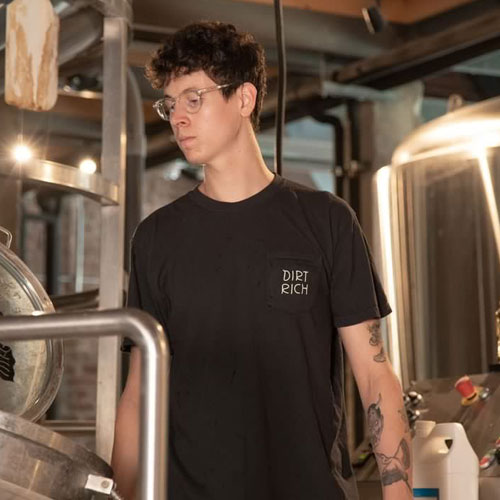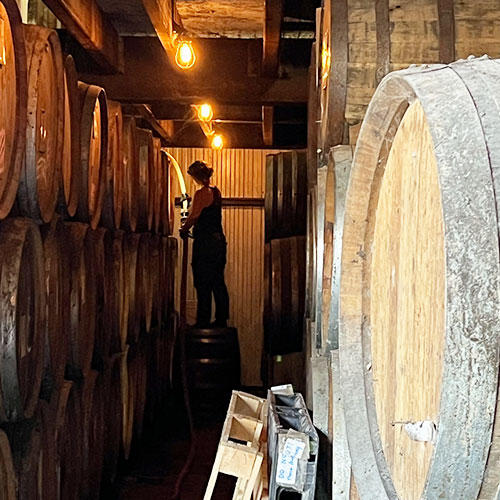In 1976, The Rolling Stones were the most sought-after live act on the planet. Their performances had surpassed “must-see” status, landing somewhere between “take out a second mortgage on your home to afford this concert” and “donate a kidney for quick cash.” If they were in town, you were either seeing them or writhing in FOMO as you spun “Exile on Main St.” in your apartment.
Massively hyped, much of the pressure for them to entertain, excite, and dazzle landed squarely on the behind-the-scenes shoulders of Johnny Starbuck, the Stones’ tried, trusted, and tested roadie. He was tasked with the performance-defining duty of equipment management and stage setup—and if he did his job flawlessly, you’d never know; Mick and Keith would sound stupendous. He existed in the ether of acclaim, only credited tangentially despite playing such a synergistic role in the overall success of the band.
The cellar person, craft beer’s unsung backbone, is much the same. Working under the radar (and oftentimes missing from those sexy mash-in action shots on your favorite brewery’s IG), the cellar person acts as the guide for any proper fermentation as they carefully chaperone a beer from day one of fermentation to serving vessel. The role itself can be traced back to 1700s Germany and even beyond in the world of winemaking; there, cellar people were responsible for the transfer of liquids as well as the maintenance of fermentation vats. Today, the role of a cellar person varies from brewery to brewery, with responsibilities falling under “cold side” duties. In reality, the role of a cellar person is much broader in scope.

“A great cellar person will work to develop and maintain an intimate relationship [with the beer] in the tanks that they are taking care of,” said Gaby Serrano, production brewer at Humble Sea Brewing in Santa Cruz, Calif. “That means taking daily logs and pH readings, capping tanks as the beer nears the end of fermentation, doing sensory, harvesting yeast, purging brite tanks, lots of fermenter and brite tank CIPs [a cleaning cycle involving hot caustic, acid, and sanitizer], minimizing oxygen exposure to avoid oxidation all throughout the production process, and doing [hop] dumps on crashed tanks.”
If that sounds like a full plate of task-oriented tedium worse than Thanksgiving with your politically opposed side of the family, you’re not wrong. But Serrano, working both in the cellar and in wort (unfermented beer) production at Humble Sea, sees the bigger picture.
“These are all tasks that can get monotonous, but they greatly impact the finished product. Equally important is understanding that a large part of the role cellar people have is to create and maintain a happy and healthy environment for the yeast. They are really the ones making the beer.”
This begs the question: what makes a good cellar person? It seems like common knowledge that brewers must possess a level of creativity paired with the precision of a Michelin-starred pastry chef. But what leads to fermentation excellence once the beer has landed in a fermentation vessel?
Attention to Detail

“A cellar person keeps an eye on every last detail.” says Andrew Turnbull, brewer at Warwick, N.Y.’s The Drowned Lands. “The best trait to have in the cellar is taking your time and making sure to go over every last step. Something is always going to go wrong in the cellar but the skills to be able to handle every situation and know the space from top to bottom are extremely important.”
Turnbull has taken on more cellarwork as of late as The Drowned Lands believes in training brewers and cellar people alike on “hot side” tasks such as brewing, milling, and recipe design. Despite being primarily focused on those tasks, Turnbull understands the importance of cellar-related duties, even if the broader public doesn’t.
“The general public certainly sees someone in the cellar as doing a lot of cleaning and grunt work and it’s not as glamorized as a brewer. [The] reality is that good cellar work can differentiate a great brewery from a terrible one.”
This sentiment is echoed by Jester King’s Sarah Lee Parker, who manages the Austin farm brewery’s barrel and blending program. For a brewery focused on mixed culture and spontaneous production, the emphasis on cleanliness and active tasting, two duties commonly attributed to cellar people, cannot be overstated.

“Those who touch the beer everyday—taste, look at the color and carb, take the gravities, temperature, etc.—know that beer the most intimately. Therefore, they’ll most likely be the first ones to notice if something is off or catch a mistake,” said Parker. “They’ll also be the best judge on whether it is even possible to make great beer from a great beer idea. Is your glycol overtaxed? Is tank 8 reliable? How long will it take to process that much fruit? [Does] the PD pump sound funny? Creating great beer involves a lot of logistics, not just a whimsical idea or hitting a gravity.”
Although Parker primarily deals with the blending and management of Jester King’s vast assortment of barrels, she values the skillset provided by those in the cellar, viewing them as similar to that of the brewing staff.
“The skills developed working the production floor as a cellar person are the same skills that make a good brewer,” believes Parker. “Ingenuity, troubleshooting, attention to detail. There are different complications that arise every day and you need to solve them quickly.”
The Keys to Success
This attentiveness and flexibility on the job is part of what makes cellarwork so challenging. It also contributes to what makes the position so difficult; focus and attentiveness almost directly contrast with the multitasking required to run an organized cellar, particularly in smaller productions like Long Island, N.Y.’s Root + Branch. Acclaimed for the grain bill experimentation that contributes to their highly sought after multi oat/wheat IPAs, Root + Branch’s production team employs one cellarman, Brad Carlin. To stay in front of a demanding schedule, Carlin emphasizes effective planning and quick reaction time as the key to success in the cellar.
“You’ve got to have a good grasp on time management,” says Carlin. “[In a given moment] you need to be able to finish a transfer, break down a tank, and [start] your next transfer all while setting up a yeast harvest or keeping an eye on a carbonating beer. Things don’t always work out as planned and the ability to quickly adjust to find a solution or give input to create a better product is really what separates the good from the great.”
The fact of the matter is, being a cellar person is an extraordinarily difficult feat. This is not to discredit the brewer or the blender or the production manager, nor the recipe designer, brewery owner, taproom lead, or social media manager. It takes a village. But the cellar person deserves their day in the sun. So many of the qualities that make beer so deeply enjoyable and dear to us can be traced directly to the people who guide, defend, and enhance the fermentation of our favorite beverage. As Carlin puts it, “The yeast makes the beer. The cellar person creates the best environment possible for it to do its job.”
So, the next time you’re enjoying your bubbly malt beverage of choice, consider the more subtle characteristics of the product. The snap of a perfectly carbonated can being cracked open. The preserved freshness of the hop bouquet emanating from your glass. The clean (or intentionally funky) flavor of healthy, sustained fermentation. And then thank the cellar person. They deserve not just our sympathy, but our respect, too.
CraftBeer.com is fully dedicated to small and independent U.S. breweries. We are published by the Brewers Association, the not-for-profit trade group dedicated to promoting and protecting America’s small and independent craft brewers. Stories and opinions shared on CraftBeer.com do not imply endorsement by or positions taken by the Brewers Association or its members.


Share Post